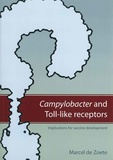Campylobacter and Toll-like receptors
Implications for vaccine development

Zoete, Marcel de
- Promoter:
- Prof.dr. J.P.M. (Jos) van Putten & prof.dr J.A. (Jaap) Wagenaar
- Research group:
- Putten , Wagenaar , Zoete
- Date:
- May 26, 2010
- Time:
- 14:30 h
Summary
Campylobacter jejuni is a Gram-negative highly motile bacterium that colonizes the intestinal tract of humans, leading to inflammation of the intestinal mucosal layer. Campylobacter-induced enteritis causes (bloody) diarrhea, cramps, malaise and fever, which resolves within two weeks. In a small number of cases, infection with Campylobacter leads to autoimmune disorders like the neuropathology Guillain-Barr頳yndrome and reactive arthritis. Chickens, which are often colonized by Campylobacter but do not develop clinical symptoms, are a major source for human infections. Because of the risk of the development of autoimmune diseases, a chicken vaccine against Campylobacter is preferred over a vaccine for humans. However, in order to develop such a vaccine, much more knowledge is needed about the chicken immune system and its interaction with Campylobacter. Toll-like receptors are innate immune receptors that function as sensors for microbial presence. The detection of evolutionary conserved microbial structures, like endotoxin, viral RNA, or bacterial flagellin, by TLRs initiates both local and systemic immune responses, leading to immune activation, microbial clearence, and efficient antibody responses. As these conserved microbial products have potent natural adjuvant activity, a thorough understanding of these molecules and their immune receptors is essential for a full understanding of bacterial infection and the rational design of new and efficient vaccines. In this thesis, the function of two chicken TLRs is elucidated. Through molecular cloning techniques, both receptors were expressed in human tissue cells and screened for potential activating ligands. Further, detailed comparitive research about the interactions of Campylobacter with the human and chicken TLR repertoire revealed a general lack of immune activation by live bacteria for both species, suggesting that immune evasion may be an important aspect of the Campylobacter lifestyle. When bacteria were disrupted, however, strong activation of human TLR2/1/6 and TLR4, and chicken TLR2/16 and TLR4 was observed. TLR5 of both species was not activated by Campylobacter. Interestingly, Campylobacter-induced activation of human TLR4 resulted in type I interferon production, which was not seen in chickens. Also, the chicken DNA receptor TLR21 was potently activated by Campylobacter DNA, whereas the human DNA receptor TLR9 was shown to be unresponsive. Finally, in order to increase the immune stimulating potential of Campylobacter for vaccine purposes, molecular cloning techniques were used to map in detail the protein region in bacterial flagellin (the major subunit of the motility apparatus) that is responsible for the activation of TLR5. Subsequently, these regions were transferred from Salmonella flagellin into Campylobacter flagellin, resulting in a glycosylated chimeric Campylobacter flagellin that strongly activates TLR5. The elucidation of a previously unknown part of the innate immune system of the chicken, in combination with the characterization of the interactions of Campylobacter with TLRs from human and chicken origin, provides unique insights into the recognition of microbes in chickens, and offer new strategies for the rational design or improvement of chicken vaccine against Campylobacter. In addition, these result may help to explain the difference in clinical manifestation of Campylobacter infection between the human and chicken host.